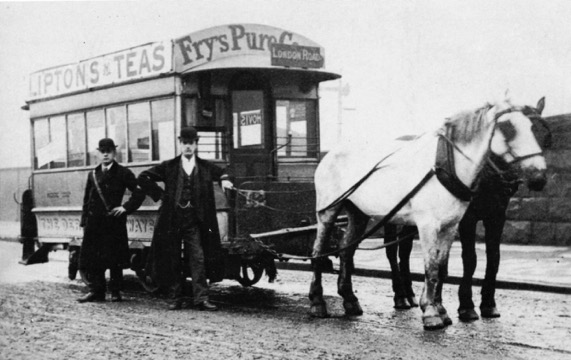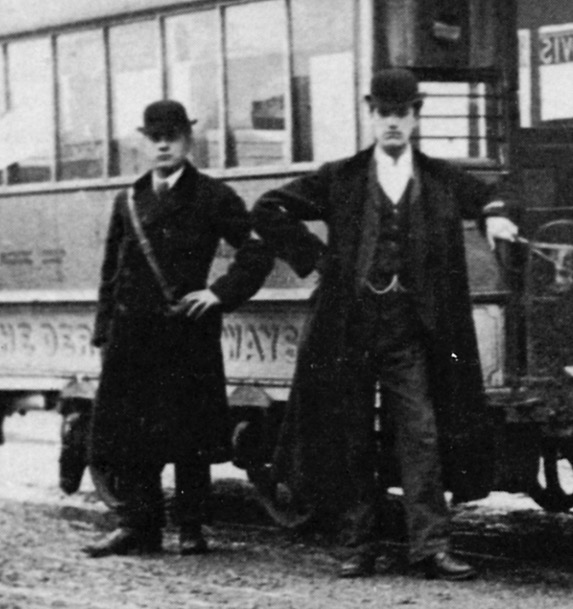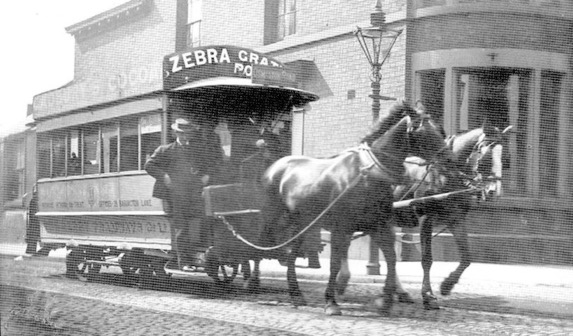Derby Tramways Company
History
Derby's 4 ft-gauge horse tramway, which was owned and operated by the London-based Derby Tramways Company, opened its first line on the 6th March 1880.
Although the DTCo had been incorporated over two-and-a-half years earlier on the 17th October 1877, gaining the corporation's agreement took some time, their initial approach being rejected. Powers to construct and operate the tramway were granted in 1879 (probably on the 15th August), construction commencing on the 29th October. As part of the agreement with the corporation, the company had to buy out all the omnibus proprietors, though quite how this was done is unclear. Whilst this gave the corporation a single transport entity to deal with, it can hardly have helped the DTCo's cash-flow, the company seemingly being under-capitalised from the start. Progress in completing the system was therefore slow, the last line out to Deadman's Lane not opening until the 14th July 1881, which took the tramway to its final size of 4.68 miles.
The system was centred on Victoria St, from where lines ran: northwestwards along Ashbourne Rd to a terminus at Windmill Hill Lane; northwards to the Market Place; southeastwards along London Rd to a terminus at Deadman's Lane, with a branch running northeastwards along Station St to the Midland Railway Company's station (Midland Station); southeastwards along Osmaston Rd to a terminus at Cotton Lane; and southwestwards along Babington Lane, then southwards along Normanton Rd to a terminus at the Normanton Hotel.
The company's forecasts proved to have been optimistic, the less-than-impressive passenger numbers, coupled with the lack of capital, quickly putting paid to any thoughts of further expansion. Although the trams were just about turning a profit, the company was losing money on the omnibus services, stopping these entirely in 1881, much to the chagrin of the locals, with whom the company appears to have had a strained relationship. Omnibus services were gradually reintroduced from 1885 onwards, which together with a reduction in fares (in 1886), led to an all-too-brief golden period when the concern was operated profitably. The cost of servicing the increasing number of passengers — extra horses, feed and men — however, soon caught up with the takings, the company having to introduce cost-saving measures to stem the losses, in the process garnering a reputation for treating its horses (and men) harshly.
Under the Tramways Act of 1870, the corporation had the right to purchase the tramway 21 years after the DTCo's enabling act, a date which would therefore have fallen in 1900, though some histories quote a date of 1898. What is clear though, is that as the date approached, the corporation began to give serious consideration to converting the horse system to electric traction, and running the tramway as a municipal enterprise. The company was clearly in no position to finance the large investment needed to convert the tramway to electric traction, so was happy to negotiate, especially so when it became clear that the corporation was willing to pay a fair price, rather than the scrap prices that many other councils endeavoured to obtain their local horse or steam tramway for. Agreement was finally reached on the 28th December 1898, no doubt to the DTCo's great relief, the company also undertaking to continue operating the tramway until such time as the corporation was in a position to take over.
The corporation obtained powers to operate the tramway on the 4th August 1899, taking over on the 1st November 1899.
The corporation continued to operate the tramway for over seven years, the last horse service running on the 1st June 1907.
Uniforms
Relatively few photos exist that show tramway staff prior to the corporation take over, but those that do clearly show that staff wore a variety of heavy duty informal attire (jacket and trousers), along with the ubiquitous bowler hat. Although the use of informal attire was common practice amongst horse tramway operators, where the Derby Tramways Company differed was in issuing a standard greatcoat-cum-coachman's coat, or at least requiring its staff to purchase them from a named supplier. These garments had distinctive collars of a darker material than the coat, but carried no insignia of any kind. However, care must be taken in extrapolating from what is after all a very small evidence base.
Conductors and drivers were required to wear an armband issued by Derby Sanitary Authority; these licence badges were oval and made of metal, though what markings they bore is unclear.
Photographs of inspectors have not survived, and indeed, it is possible that the company may never have employed them.
Further reading
For more information on Derby's horse tramways, see: 'The Story of Transport in Derby' by Barry Edwards; The Breedon Books Publishing Company (1993).
Images
Horse tram drivers and conductors
A DTCo horsecar and crew on the railway bridge on London Rd en route to Deadman's Lane — the photo is undated, but as it shows one of the original horse cars, it was probably taken in the 1880s. Photo courtesy of the Tramways and Light Railway Society, with thanks to David Voice.
An enlargement of the above photograph showing the crewmen, looking very dapper, and clearly wearing informal attire, but possibly with standard greatcoats, which had distinctive collars of a darker material than the coat itself. An oval licence, which was apparently issued by Derby Sanitary Authority, can just be made out above the conductor's left elbow.
A DTCo horse tram, possibly No 11, on the move — photo undated, but probably taken in the mid-to-late 1890s. Both figures appear to be wearing informal attire, though the driver cannot be made out properly. The man in the straw boater is certainly not the conductor, as he would have ridden inside the car or on the rear platform. Photo courtesy of the Tramways and Light Railway Society, with thanks to David Voice.